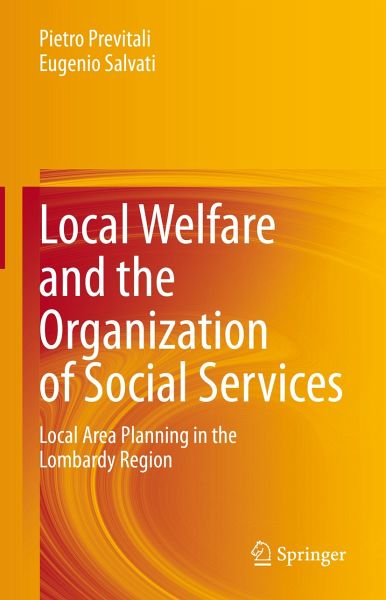
Local Welfare and the Organization of Social Services (eBook, PDF)
Local Area Planning in the Lombardy Region
Versandkostenfrei!
Sofort per Download lieferbar
52,95 €
inkl. MwSt.
Weitere Ausgaben:

PAYBACK Punkte
26 °P sammeln!
This book discusses local area planning in the Lombardy region of Italy. The book provides valuable insights about the development of local welfare systems and the territorial organization of social services through the analysis of the evolution of the Local Area Plan, which lies at the intersection of sub regional governance and of social services delivery models. Using Lombardy as a case study, this brief analyzes the structural conditions influencing the establishment of Local Area Plans, their effect on inter-municipal cooperation, and the need for possible reforms.The book is organized as...
This book discusses local area planning in the Lombardy region of Italy. The book provides valuable insights about the development of local welfare systems and the territorial organization of social services through the analysis of the evolution of the Local Area Plan, which lies at the intersection of sub regional governance and of social services delivery models. Using Lombardy as a case study, this brief analyzes the structural conditions influencing the establishment of Local Area Plans, their effect on inter-municipal cooperation, and the need for possible reforms.
The book is organized as follows: the first chapter presents a reconstruction of the national and regional framework, analyzing the structure of ties and opportunities within which Local Area Plans are called to act. The second chapter provides a review of the extant literature on Local Area Plans and introduces the theoretical framework used by the volume. The third chapter details legislation introduced in Lombardy to reform the governance structure of Local Area Plans by supporting a process of reorganization and aggregation. The fourth chapter presents some cases of Local Area Plan aggregation. The final chapter presents the conclusion and some brief considerations about the future of social planning.
Providing an empirical analysis of local service delivery, this book will be useful to scholars and practitioners interested in public administration, welfare, local government, non-profit and public organizations, and management.
The book is organized as follows: the first chapter presents a reconstruction of the national and regional framework, analyzing the structure of ties and opportunities within which Local Area Plans are called to act. The second chapter provides a review of the extant literature on Local Area Plans and introduces the theoretical framework used by the volume. The third chapter details legislation introduced in Lombardy to reform the governance structure of Local Area Plans by supporting a process of reorganization and aggregation. The fourth chapter presents some cases of Local Area Plan aggregation. The final chapter presents the conclusion and some brief considerations about the future of social planning.
Providing an empirical analysis of local service delivery, this book will be useful to scholars and practitioners interested in public administration, welfare, local government, non-profit and public organizations, and management.
Dieser Download kann aus rechtlichen Gründen nur mit Rechnungsadresse in A, B, BG, CY, CZ, D, DK, EW, E, FIN, F, GR, HR, H, IRL, I, LT, L, LR, M, NL, PL, P, R, S, SLO, SK ausgeliefert werden.












